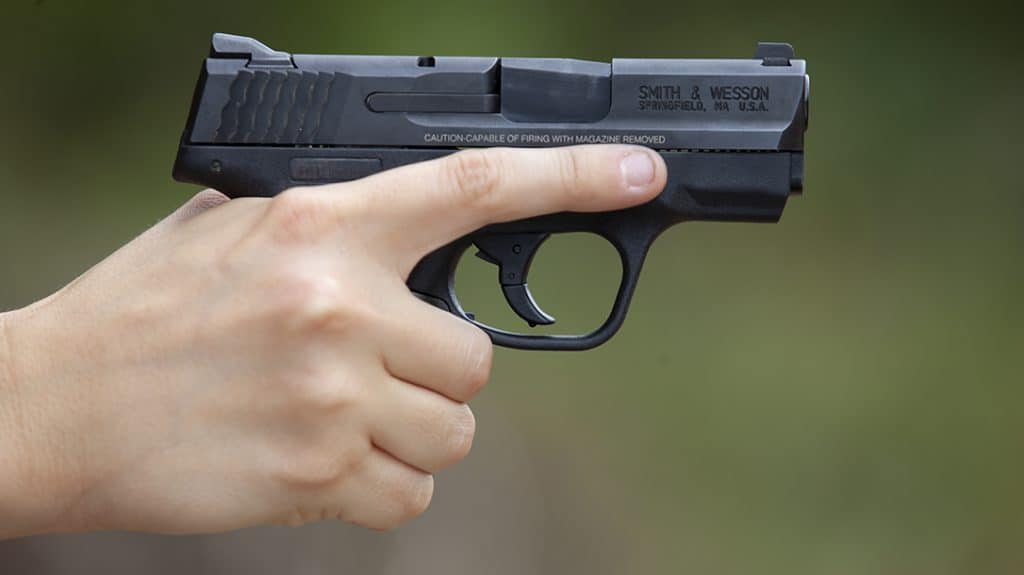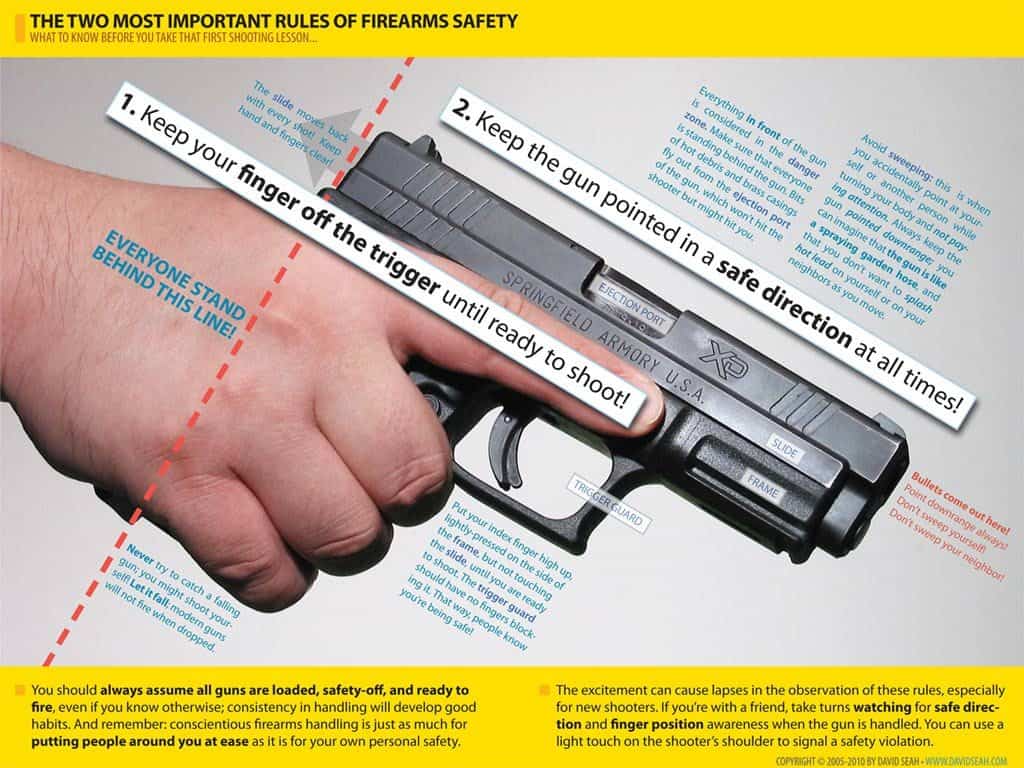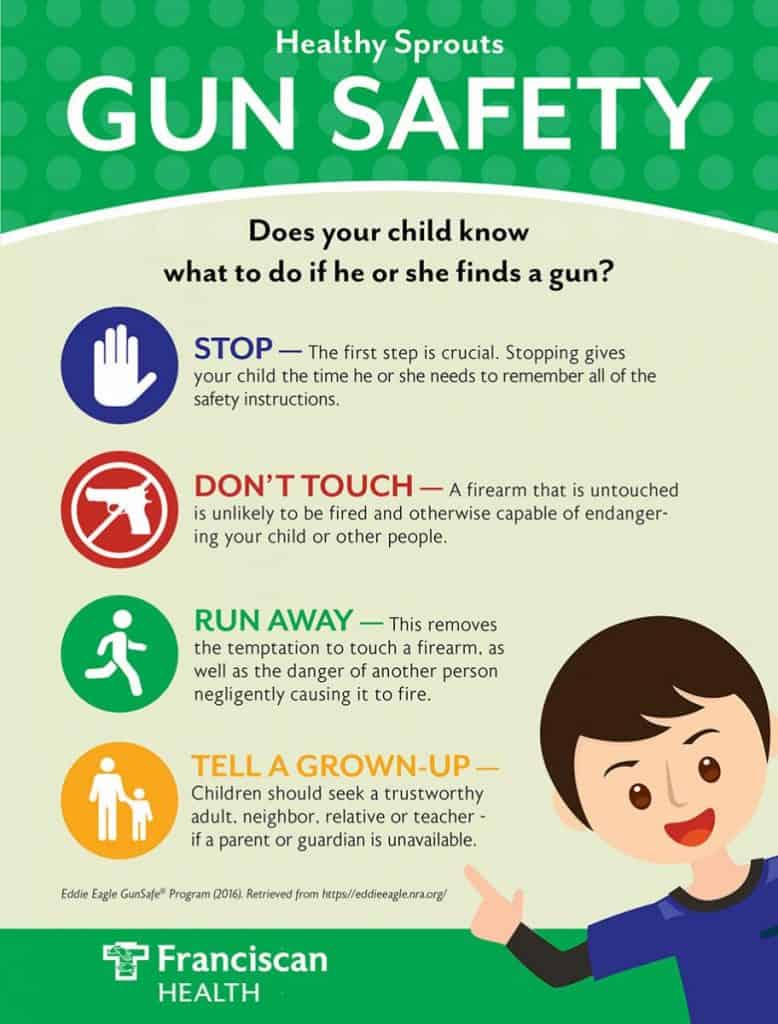If you’re handling a firearm it’s important to be safe about it. Even though firearms are popularly used in recreational sporting activities like shooting competition and hunting it is important to remember that these weapons are designed to kill or seriously maim whatever it is you are trying to shoot. As a hunter, it is easier to relate to the importance of safety but even if you are planning on shooting for fun it is important to regularly practice safe shooting and handling techniques.

Rule #1: Ensure The Muzzle Is ALWAYS Pointed In A Safe Direction
This includes when the gun is both loaded or unloaded. Even if you have just checked the action and ensured that the firearm is unloaded it is still your responsibility to keep the muzzle pointed in a safe direction. It is a safe rule to simply never have the muzzle pointed towards something you do not intend to shoot.
This is especially important when you are actively loading or unloading the firearm. Nothing in life is guaranteed except death and taxes so you should not rely on the gun being safe simply because you don’t pull the trigger. An array of events combined in an unfortunate manner can cause the gun to discharge without intention.
If you have the gun loaded remember to consider ricochet probability. If you have the muzzle pointed at a rock or at a ceiling you must consider the potential ricochet of the bullet off the rock or even the penetration of a ceiling or floor to the floor above and below you. As a firearm handler, it is your responsibility to be acutely aware and conscious of your surroundings at all times.
The final thing to mention in regards to the muzzle direction is to consider the possibility of you stumbling or falling. If you were to fall would the muzzle lose control and potentially be pointed towards someone or something you wouldn’t wish to shoot? Perhaps you can’t control everything but being mindful of this can prevent disastrous consequences.
If everyone regarded the gun as loaded and treated the muzzle in this manner then it would virtually lower the accident rate in regards to firearms down to zero. It’s also good to know that you shouldn’t fire a gun into the air. A bullet traveling upward will eventually have to come back down and it will – at high velocity.
Rule #2: Firearms Should Always Be Unloaded When Not In Use
Do not keep the gun loaded in a vehicle or inside of a building that’s not an indoor shooting range. You should only be putting ammunition into the gun’s chamber if you are in the field or at the target range and ready to shoot.
Another thing to keep in mind is to keep ammunition and the actual gun themselves completely separate while storing them for safekeeping. If the ammo is not next to the gun there is much less of a possibility of the ammo being loaded or discharged due to unforeseen events. Never be so cocky as “to know for sure” that everything will be ok. It is your responsibility to assess risk and limit risk as much as possible.
It is safe to simply always keep your gun at a minimum level of readiness and to ensure children and unauthorized people do not have access to the firearm.
When you are handing the gun off to another person you should always open the action and check the chamber and check the magazine as well. This is the mark of an expert gun handler and the person receiving the gun should repeat the process even if you just checked it. This is the same for you – if you receive the gun make sure to check the action and chamber even if the previous person JUST checked it. Two pairs of eyes are better than one.
If you are going to be climbing a tree or over a fence, just unload the gun if it’s loaded. There is no sense in carrying a loaded weapon in an awkward position that increases the risk of an accident. Also, you should never push a gun towards someone or pull it towards yourself. It should always be an equal exchange of energy moving from one person to another.
Make sure to never place the gun in a precarious position where it may fall and discharge. It is your responsibility to make sure the gun is unloaded and also just remember – nothing can fall off of the ground.

Rule #3: Don’t Rely On Your Gun’s Safety
The safety is a feature that disables the gun’s ability to fire even if the trigger is pulled. However, it is a mechanical feature and anything mechanical is subject to failure the longer that time goes on. Therefore it is important to never rely on your safety as an absolute that the gun will not fire.
It is also possible that you might have a slip of the mind where you believe that it is on but it is actually off. This also relates to why you check the chamber every single time before you hand the gun over. The safety is an assistant to you, but it doesn’t run the show. You do!
Another key element of gun safety is to never touch the trigger unless you are ready to shoot. This even means if you are aiming at the target but someone is talking to you and you’re not shooting yet. Only when you are actually going to discharge the weapon should you place your finger on the trigger. This rule applies even when the safety is on or you are unloading or loading the weapon.
Rule #4: Be Sure Of Your Target And What’s Beyond It
You must be absolutely sure of what is beyond your target that you are shooting. At a shooting range, you will generally have a backdrop or something behind the target, but it is always good to double check. If you are hunting you always need to make sure what’s behind your target. If you shoot a buck but a doe is behind him you could accidentally injure or kill the doe as well and you would have to take ownership for that.
It’s good to know how far your bullet will travel so you are aware of the range your bullet will travel, especially if you miss your shot. As a guideline of popular calibers: .22 bullet can travel 1.25 miles, a 30-06 can go 3 miles, shotgun pellets can go 500 yards and slugs can travel over half a mile.
Also, do not shoot at movement or a sound. It could be another hunter. If you “hear a turkey” how do you know that it’s not a hunter with a turkey call? Make sure you can see what you’re shooting at.
One last thing to keep in mind is to never shoot at a hard surface and this also includes water. Although water is not a “hard” surface the density of water can cause a bullet to glance off of the surface and create a ricochet effect.
Rule #5: Use The Right Ammo For Your Gun
Using the wrong type of ammunition can actually ruin your gun and can also cause serious personal injury. It can take just a single bullet that can ruin your gun or even your life. Be conscious of the ammo you are putting in your gun.
It’s good to know that if ammo gets wet or submerged in water should be considered defective. It can cause a misfire or another catastrophe so it is best to safely discard bullets that have been exposed to these elements of water. It’s also good to discourage the use of lubricants and oils or over-lubricating your chamber as this can cause misfires of the ammo as well.
Rule #6: If Your Gun Fails To Fire When You Pull The Trigger, Handle With Care!
It is important to take extra care after pulling the trigger if your bullet does not fire. At this point, it is safe to treat it as a live shot that can discharge at any time. Again, keep the muzzle pointed in a safe direction but be hyper-conscious of it if you find yourself in this situation.
The next step you should take is to carefully and slowly open the action of the gun to unload the bullet and discard of the bullet safely. Do NOT fire the weapon twice to try and get the bullet to fire. The bullet should be considered defective and not safe to use if it does not fire on the first pull of the trigger.
Rule #7: Always Wear Ear And Eye Protection When Shooting
Exposure to gun noise can lead to tinnitus which is a constant ringing sound in your ear from damaged hearing. The eye protection will protect you against basic elemental events and also if the gun has any mishap or an unforeseen explosion or discharge happens, such as accidentally firing and shooting a rock that creates shards flying in all directions.
It is also good to use eye protection while cleaning the weapon to avoid eye contact with any solvents or cleaning material. If you are firing a weapon or cleaning the weapon always ensure that you are in a well-ventilated area so that you are not breathing in the firearm’s discharge or the solvent/cleaning vapors.
Rule #8: Be Sure That The Barrel Is Clear Of Obstructions
We will start by advising that you should never, ever look down the barrel of the gun, even if it is unloaded. You can check the barrel of your gun with a cleaning rod to ensure that the barrel is clear of any dirt or even bullets that didn’t discharge properly. Also, if you fire the gun and it doesn’t sound quite right you should immediately check the bullet of the gun to ensure there is no blockage or disturbance existing inside the barrel of the gun.
Rule #9: Don’t Alter Or Modify The Gun
Guns are made by professionals and designed with your safety in mind. It is best to never alter or modify a gun to achieve some desired result as this can greatly increase the chance of personal injury or injuring those around you. This can also void the manufacturer’s warranty of the firearm in the event that something goes wrong.
Also, to ensure maximum efficiency and safety of your firearm, you should check your manufacturer’s guidelines on how often you should have your gun serviced and then adhere to this schedule.
Rule #10: Become Familiar With Your Gun
If you are going to use the firearm, it’s good to become familiar with it. This could be as simple as cleaning the gun and even practicing aiming it at the range before firing it. If someone is giving you their gun to try out you should always ask them questions about the basics of using it to ensure that you have a good understanding of the equipment before firing it yourself.
Some basic tips include tips for handguns, rifles, and shotguns. A handgun is advised to be carried with the hammer down, not cocked when the gun has an empty chamber. A rifle should always have the action opened when it is not ready to fire and a double barrel shotgun should have the barrel “split” so that the chambers are clearly visible to easily see that it is unloaded.
In firearm handling and safety, you never guess and always familiarize yourself.
Rule #11: Be Mindful Of Your Mental State
It is important to never handle a gun when you are in an emotional state such as anger or depression. A gun is not something to turn to so that you can “let off steam” if you are frustrated. It simply increases the chance of an unfortunate, dangerous event to occur and it would be best to avoid it.
Do not use a weapon if you are using alcohol or drugs. If you are in an altered state of mind it will inhibit your ability to adhere to these safety guidelines. Also, avoid threatening situations. Don’t try to be a superhero and enter into a heated situation with a gun. If you wouldn’t do it without a gun, don’t do it with a gun.
Rule #12: Educate Everyone In Your Home
If you keep firearms in your home it’s important that everyone is aware of the guns that are present and also aware of these safety steps. This is especially important for children. Make sure you teach children about the guns and that they are aware of the potential dangers that can occur if handled improperly.

That’s it!
Shooting and hunting are considered a safe sport and if you follow these guidelines you will help continue that tradition! Firearms receive a lot of disdain from anti-firearm politics and protests so it’s important to take on the responsibility of creating a safe environment when a firearm is involved. Keep to these guidelines and you will be contributing to a more positive outlook on firearms and also ensure the safety of you and the people around you! Good work and happy shooting!
If you enjoyed this article you’ll probably like these:


